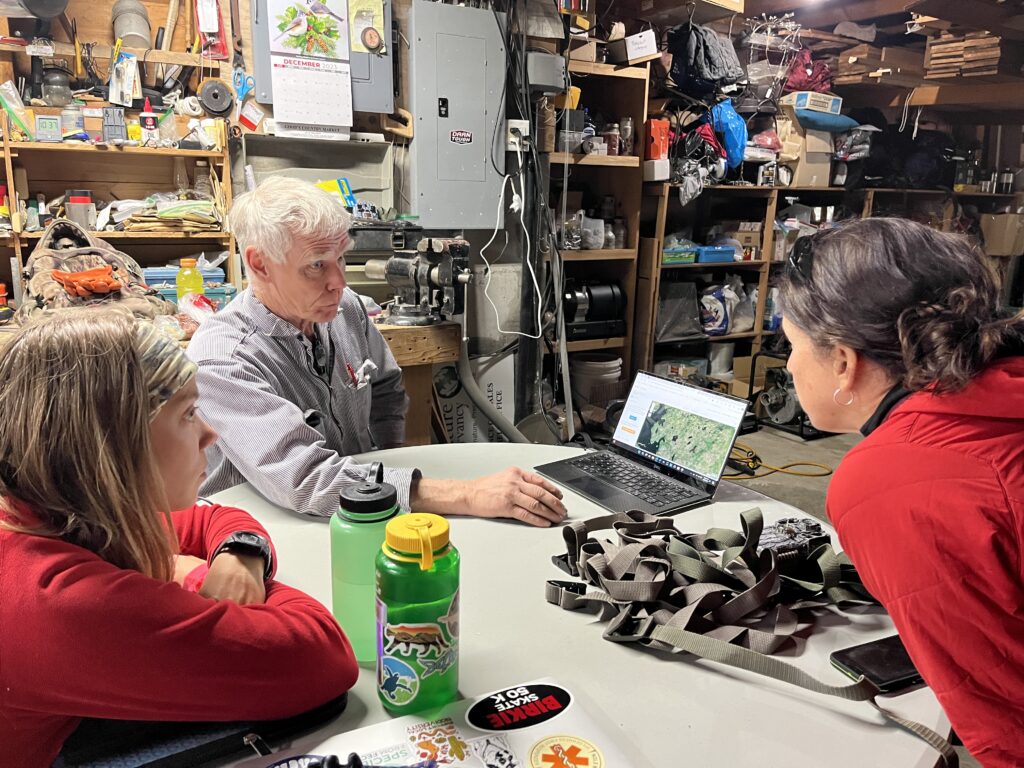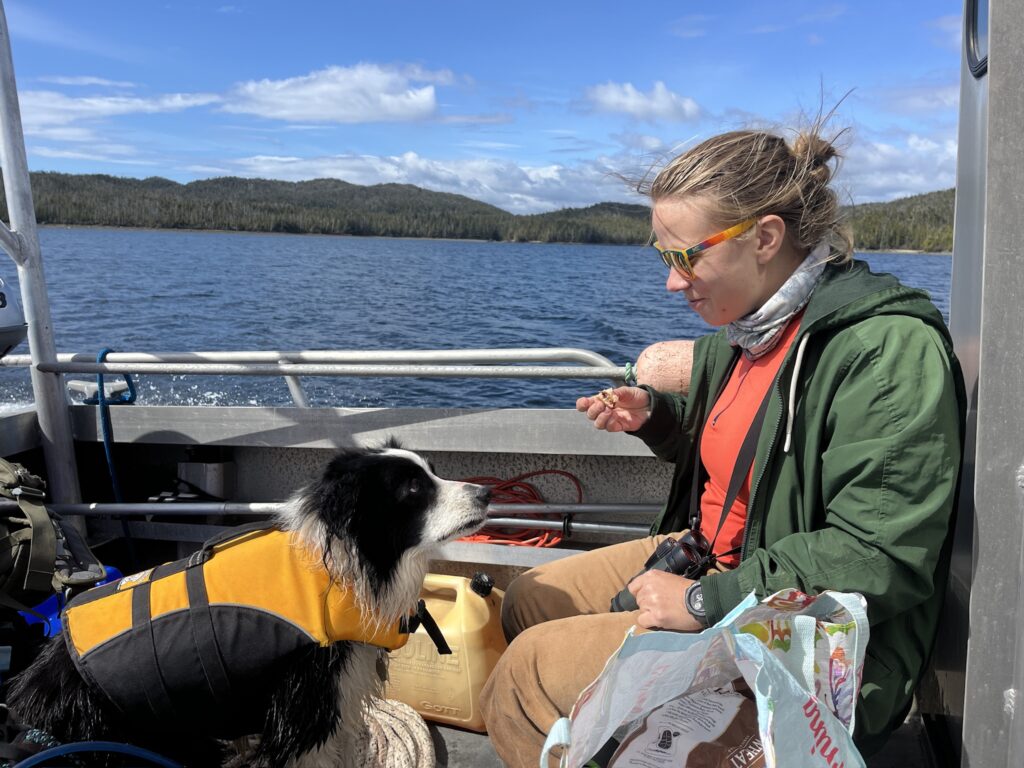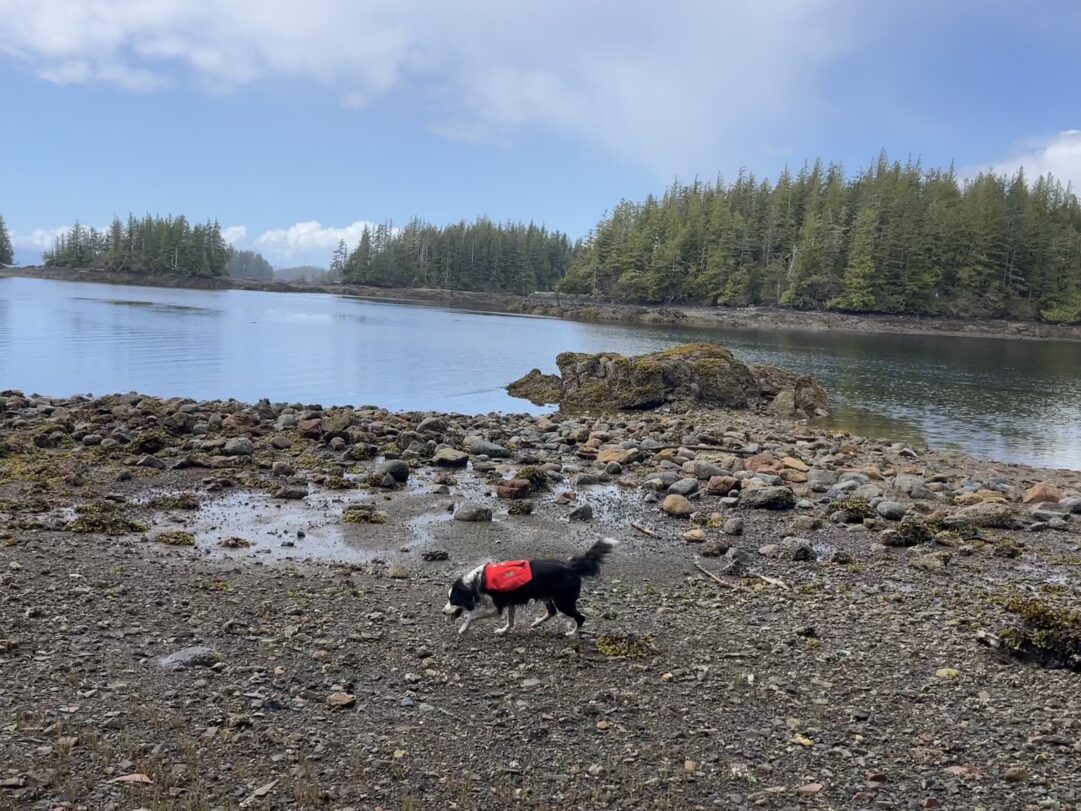Barley’s paws are splayed out, his claws gripping the planks of the dock. He does not trust these sturdy planks, but he follows me reluctantly past gillnetters and boats piled high with crab pots. It is our first full day in Craig, Alaska, and we are going to take the boat out for a test drive. The aluminum boat is 25 feet long, shiny and gray and nameless. The front cabin has two seats with a 270* view of the sparkling water and heaping islands and bench seats with limited views behind. A large closed hull for gear takes up much of the bow. Behind the cabin, an open deck offers storage for our little dinghy, a staging area for gear, and unfettered access to all of the elements Alaska has to offer – good, bad, and ugly.
I lift Barley into the boat and he tucks himself into a corner, shaking and shifting. He can’t seem to find a place that feels comfortable. I am sick to my stomach. We have 3 solid months of boat-based surveys ahead of us, and I can’t stand the thought of my beloved partner being this distressed by his daily commute. Barley has never been this worried about boats before. He’s ridden on ferries, open motorboats called lanchas in Central America used for open sea, canoe-like skiffs called pangas common in Central America’s rivers, and even a stand-up paddleboard. But today, as we clamber onto the boat, he is concerned.

When we reach our destination, a gorgeous intertidal zone checkered with plush grass and crystalline pools, I let him hop off the bow and swim a few meters to shore. He shakes the stress right off and takes to the trees, tail waving and nose sampling the rich Alaska air. We do a quick practice search before returning to Craig. If there is one thing that will help Barley learn to trust the boat, it is learning that the boat delivers him to work. When we return to the dreaded dock, our captain Michael Barley grabs an “emotional support buoy” from among the driftwood. He clamps it in his teeth, noticeably brighter. Buoys have been a lifelong fascination of his – these multicolored bobbing dog toys that endlessly evade his attempts to retrieve. He’s been known to thieve buoyed fishing nets and swim circles endlessly around the large circular buoys, trying to herd them ashore. Perhaps we will start a reclaimed buoy dog toy company called’ Barley’s Buoys.

When Gretchen, the Alaska Department of Fish and Game (ADFG) biologist we’re working with arrives, the work really begins. We spend the next few days programming camera traps to our desired specifications. Michael, who really is more of a collaborator and guide than a boat captain, describes den sites, camera trap locations, his buddy’s traplines, and recent wolf interactions from the community in exquisite detail. Gretchen follows up with information from her GPS collars and other ADFG research, painting a fuller picture of the entire island system. I am still unfamiliar with the area and soon my head is swimming. There are so many places to search, so many likely areas to check for wolf scat. How will we possibly do this project justice? I feel small and inadequate for such a massive and fascinating project. This seems like real biology, and I’m just a dog trainer, right? I click through endless screens on the camera traps, repeatedly losing my place among the settings as my mind snags on anxieties.
The next morning breaks hazy and soft, the sun blinking blearily through the clouds and briny wind. We pile drybags and tubs of gear into Michael’s truck. Barley, Gretchen, and I perch atop the gear in the bed while Michael and Toni take the cab a few blocks to the marina. As we cart gear down to the boat, Barley hops in unprompted. He is still tense, but when I offer his favorite blanket atop a bench seat, he curls up and waits for us to finish loading the gear, his tongue poking out of his closed muzzle. We idle out of the marina and Michael eases the boat into its cruising speed of 20 miles per hour. The day flickers into clarity, bright sunlight pouring over the archipelago and making the water sparkle like hoarfrost. We spot distant humpback whales, sea otters, Pacific white-sided dolphins, harbor porpoises, and the occasional harbor seal. Toni is in birding heaven, her binoculars always at the ready as she rattles off the names of murres and auklets that she hopes to see. I bury myself in John Muir’s Travels in Alaska, at once delighted in his poetic descriptions of the very islands we’re puttering past and disgusted by his often-racist descriptions of Alaskan natives.

A few hours later, we arrive at our first search area – a likely-looking muskeg on a tiny island. We offload and Barley starts barking as I shoulder my pack. He barks as I adjust his GPS collar. He barks when I tell him to search. For the rest of the day, he barks in joy and frustration and enthusiasm. He’s not usually much of a barker, but I suppose age and experience means that you’ve got more to say at work. Our way up to the beaver ponds is steep and crossed with endless deadfall. We shimmy under Alaskan limbo logs and heave ourselves over mossy hurdles. Our enormous camo waterproof boots become heavy as we pick our way through the hummocks, not with water weight but with fatigue. Eventually the forest opens into a gorgeous, sunny, soft muskeg where travel and searching is much easier. Barley’s frustration grows as the search goes on; there is no wolf scat here. In desperation, he points out a few mink scats. I apologize as Barley barks his disgruntlement at me; I cannot pay him with his beloved ball for these scats. Despite Barley’s frustration, it is a gorgeous day. The beaver pond is sapphirine, reflecting the deep green conifers and Easter-egg sky. We weave around the pools, basking in the sunlight whine Barley sniffs his hardest. There’s just no wolf scat to be found.

When we return to shore, Michael parallel parks the boat in deep water against a sheer dropoff so that Barley can easily hop on. I clamber aboard and call Barley. He dances on his front paws, tail waving as he assesses the situation. Rather than hopping directly onto the boat, he opts to leap into the frigid water and swim around to me. I coax him into dodging the motor and pull him aboard. Luckily, this is the only time he takes the marine boarding route. I am already exhausted, but it is only 2pm so we decide to try another search area. Toni and I shovel down PB&J sandwiches as Barley tries his Jedi mind control his way into one as well. I heap a glob of extra chunky onto a bit of bread and let him slurp it down. His eyes widen at his mind-control success and he greedily turns his gaze to Toni’s sandwich.

We arrive at a spacious intertidal zone that encircles a soft green glen of old growth. I am delighted by the snapping and popping of bladderwrack under my boots, but it’s time to work. Within moments of putting his nose to the wind, Barley hangs a hard right. He circles, steps slowing and wags quickening. He folds into a down, head low, eyes on me, tail wagging softly. I pick my way across the barnacles and slick grass and catch a glimpse of a large scat between his paws. Wolf, finally! It’s odd-looking, though – mostly crab and invertebrate shells. I call Gretchen over to confirm, my heart in my throat. I can’t throw Barley’s beloved ball on an uncertain scat, especially this early in a project. She gives her confirmation and we throw Barley a huge party. Within the hour, we had six or seven more scats in neatly labeled baggies.

As we bask in sunlight filtered through gauzy lichens and our successes, we decide to camp right here. The bay is glassy, the copse of cedars seem fit for faeries, and frankly we’re beat. We fireline endless drybags of gear. I select a mossy flattish high point for Barley and my tent. I make him a nest of blankets and clothes, but he is off attempting to retrieve a 2-foot-diameter log. I find him grunting and bracing himself against the log, ripping off chunks. He doesn’t know he’s got to work again tomorrow and needs to rest. I call him to a sunny patch of grass and tether him, limiting his options. He almost immediately settles and falls asleep.

I drop our egg noodles into the ocean while draining them for dinner, but we scoop most of them up and are able to rinse and re-boil them. They are delicious with peanut sauce and some veggies. This area has a very high density of black bears (luckily no brown bears), so we collect all of the food and smelly items to fireline back onto the boat after dinner. Our bear spray is always at the ready. Michael guides the boat to deeper water and drops anchor before paddling a teeny tiny inflatable dinghy back to shore.
The next morning Barley wakes up very, very sore. He has had a stiff left rear leg on and off since he was five. After big activity days or sleeping on hard ground, he often limps for a step or two. We’ve had imaging done by two orthopedic vets and he regularly sees a sports medicine vet, and after making some adjustments I haven’t seen the limp for two or three years. But this morning he is holding his leg up, determinedly hobbling about the tent.

I start to spiral. Did I make a mistake bringing my 10 year old on this long and hard of a field season? Should I have forced us to turn back on that awful muskeg? Why didn’t I bring my younger dog Niffler, at least as backup? Did I let my love of Barley and desire to work 1:1 with him cloud my judgment and injure him? Or worse, did the economic prospect of having Niffler work a paid job sway my poor grad student decision? I’d like to say that I went into problem-solving mode right away, but I just stared, frozen, at my poor sore dog. It took me another two days and a lot of silent crying to become solutions-oriented.
As he always does, within a minute or two Barley is walking on all four paws again. I can tell he is still sore; he doesn’t stretch his hind legs during his morning sun salute and his shake-offs are abbreviated. At a walk and a trot his gait looks smooth, but kick it up a gear and he is rocking slightly, relying too much on his front legs. The others say he looks fine, but to me he looks old. My stomach is in knots. We all inhale our breakfasts and Barley starts to play at the shoreline. I tie him up again to save his energy, feeling relieved that he is well enough to be a menace to the sticks of the island.
We chatter as we clean up, ferrying gear back and forth and heating water to clean dishes. We are basking in the early morning sunlight, repeatedly remarking on the divine weather, when Michael hushes us. He points toward the head of the bay and hisses, “Wolf!”
We love to hear from you. Please share this post and ask us questions in the comments if you enjoyed this piece. It helps us know you’re there and feel inspired to continue sharing stories.

